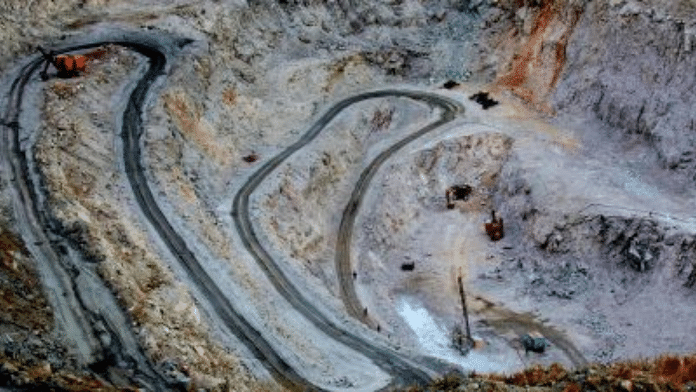New Delhi: India has identified 30 critical minerals that it considers essential for economic development and national security of the country in order to ensure “self-reliance” and to address “the vulnerability” in its supply chain.
At an event held Wednesday, Minister of Parliamentary Affairs, Coal and Mines, Pralhad Joshi released the ‘Report of the Committee on Identification of Critical Minerals’, which comprises the list of thirty critical minerals, including antimony, beryllium, bismuth, cobalt, copper, gallium, germanium, graphite, hafnium, indium, lithium, molybdenum, niobium, nickel, phosphorous, potash, titanium, tungsten and rare earth elements.
This list will be revisited periodically, government officials have said.
With a few exceptions such as copper, gallium (discovered as a by-product while producing alumina), graphite, cadmium (discovered as a byproduct during zinc smelting and refining), phosphorus, potash, and titanium, India is 100 percent import dependent for most of these minerals. According to experts in the sector, even today, only about 10-20 percent of India’s real potential vis-a-vis critical minerals has been explored.
The latest development is crucial because of the importance of these minerals — from mobile phones to electric vehicles, solar panels, semiconductors and wind turbines, all modern technologies are dependent on critical minerals such as lithium, graphite, cobalt, thalium and rare earth elements. Such minerals are essential not only in high-tech electronics and telecommunications, but also in transport and defence.
While most countries in the world have identified critical minerals according to their national priorities and future requirements, India hadn’t done so until now.
In November 2022, the Ministry of Mines had set up a seven-member committee under Veena Kumari Dermal, joint secretary in the mines ministry, to identify a list of such critical minerals.
Speaking on the occasion, mines secretary Vivek Bhardwaj said the release of the first list of critical minerals is important because it sends a message to the world and the industry that India is trying to ensure that its supply chains don’t get disrupted.
“It is also important because we need to focus on these minerals. Many of us may not know that India produces 95 minerals today. But this list gives us renewed focus on where we need to double our energies, efforts and ensure that there is no disruption in the supply chain,” he said, adding that Canada, the UK and Australia also came out with their list of critical minerals last year.
Also Read: How lithium deposits found in J&K could help bring down cost of electric vehicles in India
Fertilisers on the list
Speaking on the occasion, Bhardwaj said that the committee set up last November tried to understand the “economic importance of each mineral, the strategic importance, our dependencies on other countries, the domestic availability”.
“…through a very meticulous three-stage process we have come to this list of critical minerals in the country,” he said.
In the first stage, the critical mineral strategies of various countries such as Australia, USA, Canada, UK, Japan and South Korea were studied, according to Bhardwaj. Accordingly, 69 elements/minerals that were considered critical by major global economies were also identified for future initiatives.
In the second stage, an inter-ministerial consultation was carried out with different ministries to identify minerals critical to their sectors. The ministries of power, new and renewable energy, as well as the departments of atomic energy, fertilizers, science and technology, pharmaceuticals and NITI Aayog — the government’s advisory body— gave their comments and suggestions.
The third stage involved deriving an empirical formula for evaluating mineral criticality.
Based on this three-stage assessment, the net import reliance and the resource/reserve position of the country, a total of 30 minerals were found to be most critical for India, Bhardwaj said.
India has also included fertilisers in its list of critical minerals.
On this, Bhardwaj said: “This is because we are a country, which is one of the largest exporters of rice and wheat in the world, we need to support a large population and also farmers. Therefore fertilisers are very important to us”.
(Edited by Uttara Ramaswamy)
Also Read: Rare earths, their strategic significance, China’s monopoly & why it matters to the Quad



